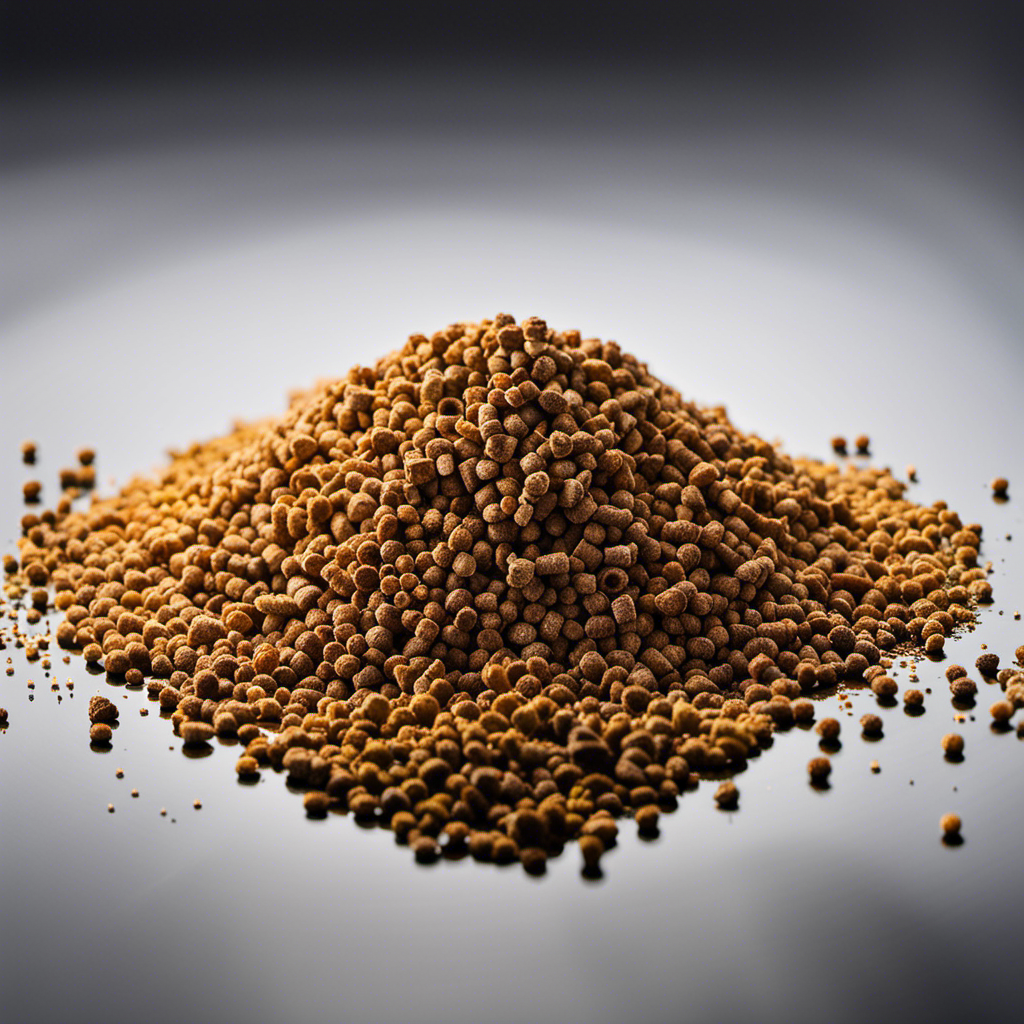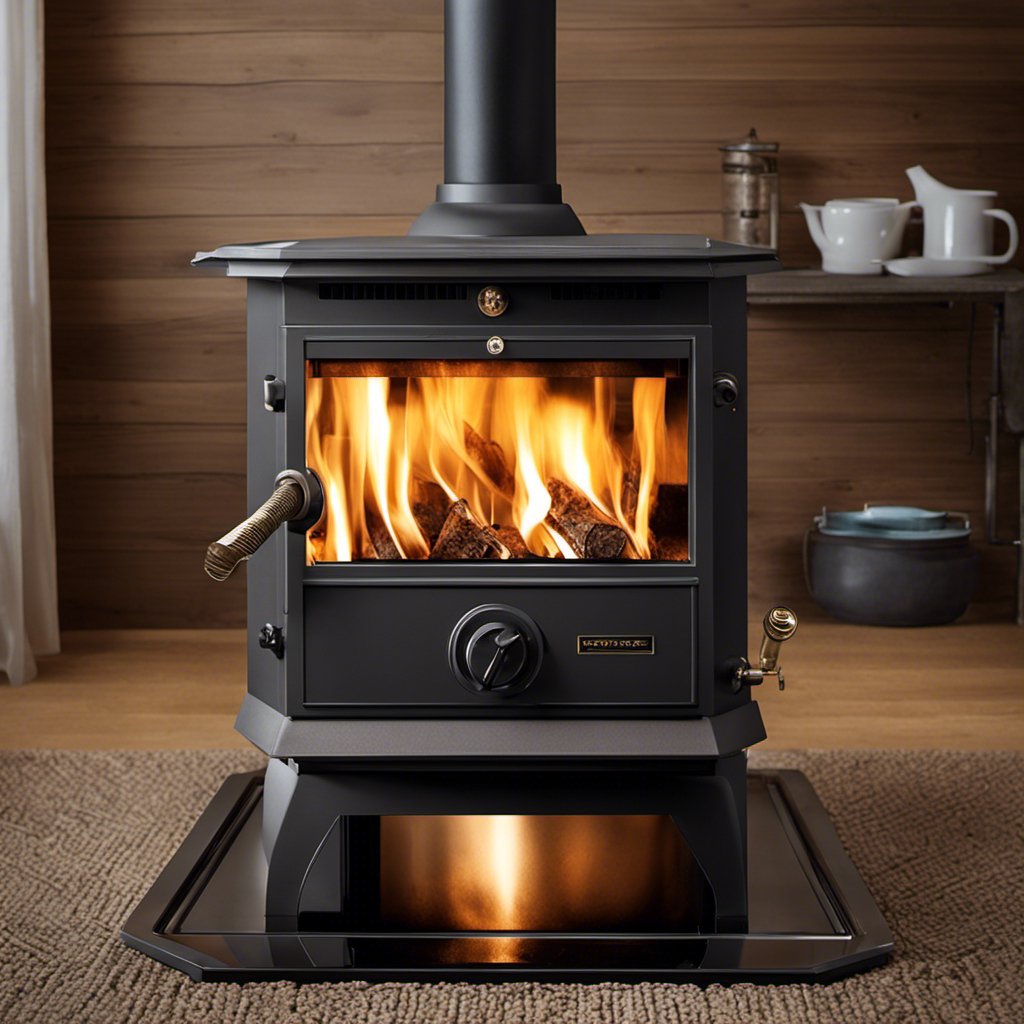I’ve always held a fascination for the workings of wood pellet grills, which led me to embark on a journey to deepen my understanding of them.
Did you know that wood pellet grills have become increasingly popular in recent years? It’s true!
These innovative grills use wood pellets as fuel, which not only adds a unique smoky flavor to your food but also allows for precise temperature control.
In this article, we’ll explore the inner workings of a wood pellet grill and learn how it can revolutionize your outdoor cooking experience.
Key Takeaways
- Wood pellet grills use a digital control system and motor feeding pellets to adjust fire intensity and temperature.
- Wood pellets made from compressed sawdust create efficient heat generation and even heat distribution.
- The temperature control system includes a control panel and digital display for adjusting temperature.
- Regular cleaning and maintenance, including checking for grease buildup and lubricating moving parts, ensure optimal performance of wood pellet grills.
The Basics of Wood Pellet Grills
Wood pellet grills use small wood pellets to create heat and smoke while cooking. These grills have gained popularity in recent years due to their numerous benefits.
One of the main advantages of using a wood pellet grill is the ability to achieve a smoky flavor in your food without the need for traditional charcoal or gas. The type of wood pellets used can also enhance the taste of your dishes, as different woods impart unique flavors. For example, oak pellets provide a strong, robust flavor, while fruitwood pellets like apple or cherry add a sweet and fruity undertone.
Now that we understand how wood pellet grills work and the benefits they offer, let’s delve into the components that make up these versatile cooking machines.
The Components of a Wood Pellet Grill
When it comes to understanding the inner workings of a wood pellet grill, it’s important to start with the key components that make up this innovative cooking device.
From the hopper and auger system to the digital control panel and fire pot, each component plays a crucial role in delivering consistent heat and smoke for an exceptional grilling experience.
Key Grill Components
To operate a wood pellet grill, you’ll need to understand the key components such as the hopper, auger, and fire pot. These components are essential in ensuring that the grill functions properly and efficiently.
The hopper is where you store the wood pellets, which serve as fuel for the grill. The auger is responsible for delivering a controlled amount of pellets from the hopper to the fire pot. The fire pot is where combustion occurs and generates heat for cooking.
This design allows for precise temperature control and even heat distribution throughout the grilling surface. Understanding these key grill components will enable you to effectively utilize your wood pellet grill and achieve delicious results every time.
Now let’s delve into how all these parts work together in the working mechanism explained section.
Working Mechanism Explained
You’ll be amazed at how all the key components of your wood pellet grill work together to create the perfect cooking environment. Let me explain the working mechanism in detail.
The heart of a wood pellet grill is its digital control system, which allows you to set and maintain the desired temperature with precision. This control system connects to a motor that feeds wood pellets into a firepot located at the bottom of the grill. By adjusting the speed and amount of pellets being fed, you can control the intensity of the fire and thus, regulate the cooking temperature.
The firepot contains an igniter rod that starts burning the pellets, creating heat and smoke for flavor infusion. Now that we understand how all these parts work together, let’s delve into how wood pellets fuel the fire effortlessly.
Transitioning seamlessly into our next section on ‘how wood pellets fuel the fire,’ it’s important to note that understanding this process will give you insight into why wood pellet grills are so efficient and easy to use.
How Wood Pellets Fuel the Fire
When it comes to understanding how wood pellets fuel the fire in a grill, it’s important to grasp the combustion process.
Wood pellets are made from compressed sawdust and contain very low moisture content, which allows for efficient heat generation. This means that they burn cleanly and produce less smoke and ash compared to traditional charcoal or propane grills, making them an environmentally friendly option.
Combustion Process Explained
Once the wood pellets are ignited, they undergo a combustion process that generates heat and smoke for cooking on the grill. This combustion process optimization is one of the key benefits of using wood pellets.
When you light the pellets, their compact shape and uniform size allow for efficient burning. The controlled airflow inside the grill ensures proper oxygen supply to support combustion without smoldering or excessive flames.
As the pellets burn, they release heat energy through a chemical reaction with oxygen, producing carbon dioxide and water vapor as byproducts. This clean-burning process eliminates the need for lighter fluid or propane gas, making it an environmentally friendly option.
Furthermore, wood pellets provide consistent heat output throughout the grilling session, allowing for precise temperature control and even cooking.
With this understanding of how wood pellet combustion works, let’s explore how it leads to efficient heat generation in the next section about ‘efficient heat generation’.
Efficient Heat Generation
The combustion process with wood pellets in a grill produces consistent heat for efficient cooking. Wood pellet grills are designed to generate and distribute heat evenly throughout the cooking surface, ensuring that food is cooked thoroughly and uniformly. The advantage of using wood pellets is that they provide a steady source of heat due to their high energy density and low moisture content. This allows for precise temperature control, helping you achieve perfect results every time you grill.
Additionally, wood pellets produce less smoke compared to traditional charcoal or gas grills, resulting in a cleaner and more enjoyable cooking experience. With their efficient heat distribution and numerous advantages, it’s no wonder why wood pellet grills have become increasingly popular among barbecue enthusiasts.
Transitioning into the subsequent section about the environmental benefits of pellets, it’s important to note that not only do wood pellets offer efficient heat generation but they also have several eco-friendly advantages.
Environmental Benefits of Pellets
Using wood pellets in grilling not only produces efficient heat, but also offers several eco-friendly advantages.
Wood pellets are a renewable energy source made from compressed sawdust and other wood waste materials. They are created without the use of harmful chemicals or additives, making them a cleaner alternative to traditional charcoal or gas grills.
When burned, wood pellets release significantly fewer carbon emissions compared to fossil fuels, reducing their environmental impact. This makes them a more sustainable option for outdoor cooking enthusiasts who want to minimize their carbon footprint.
Additionally, because wood pellets are made from waste materials, they help decrease the amount of wood waste that would otherwise end up in landfills.
Transitioning from this ecological perspective into understanding the temperature control system of a wood pellet grill is essential for achieving optimal results and mastering the art of grilling.
Understanding the Temperature Control System
To control the temperature on a wood pellet grill, you’ll need to adjust the settings on the control panel. This is one of the many advantages of using a wood pellet grill for cooking.
Here are three important things to know about the temperature control system:
-
Consistent Heat Distribution: The temperature control system in a wood pellet grill ensures even heat distribution throughout the cooking chamber. This eliminates hot spots and allows for consistent cooking results.
-
Easy Adjustments: With just a few adjustments on the control panel, you can easily set your desired temperature. The digital display makes it simple to monitor and make changes as needed.
-
Troubleshooting Fluctuations: If you experience temperature fluctuations, there are a few troubleshooting steps you can take. Check that the pellets are feeding properly into the fire pot and ensure that there is no build-up of ash or debris in the burn pot or exhaust system.
Now that we understand how to control the temperature on a wood pellet grill, let’s explore some cooking techniques and tips to enhance your grilling experience.
Cooking Techniques and Tips on a Wood Pellet Grill
Now that we’ve covered the temperature control system, let’s dive into some cooking techniques and tips for a wood pellet grill. One of the great things about a wood pellet grill is its versatility in cooking different types of food. Whether you’re grilling, smoking, or baking, there are a few key techniques to keep in mind. First, preheat your grill to the desired temperature and then add your food. This ensures even cooking throughout. Second, use flavored wood pellets to enhance the flavor of your dishes. Hickory for a smoky taste, applewood for a sweet aroma, or mesquite for a bold flavor. Lastly, don’t be afraid to experiment with marinades and rubs to further enhance the taste of your grilled creations.
| Cooking Technique | Description | Flavor Enhancement |
|---|---|---|
| Direct Grilling | High heat | Charred |
| Indirect Grilling | Low heat | Tender |
| Smoking | Slow smoke | Smoky |
Cleaning and Maintenance of a Wood Pellet Grill
By regularly cleaning and maintaining your wood pellet grill, you can ensure its longevity and optimal performance. Here are some essential cleaning techniques and a maintenance schedule to keep your grill in top shape:
-
Clean the grates: After each use, scrape off any leftover food particles with a grill brush. For a deeper clean, soak the grates in warm soapy water and scrub them thoroughly.
-
Empty the ash pan: Remove and empty the ash pan regularly to prevent buildup that can affect airflow and temperature control.
-
Check for grease buildup: Grease can accumulate on various parts of the grill, including the drip tray and heat deflector. Clean these areas with warm soapy water or a degreaser to prevent flare-ups.
For general maintenance, inspect all components for wear and tear regularly. Lubricate moving parts if necessary and follow the manufacturer’s recommendations for any specific maintenance tasks.
Frequently Asked Questions
Are Wood Pellet Grills Suitable for Both Grilling and Smoking?
Yes, wood pellet grills are suitable for both grilling and smoking. They offer the convenience of easy temperature control, consistent heat distribution, and the ability to infuse food with smoky flavor.
Can I Use Regular Wood Chips or Charcoal in a Wood Pellet Grill?
Using regular wood chips or charcoal in a wood pellet grill is not recommended. Wood pellets are specifically designed for use in these grills, providing consistent heat and flavor. However, some people may experiment with other fuels, but it can affect the performance and taste of the food.
How Long Does It Take for a Wood Pellet Grill to Reach the Desired Temperature?
It takes about 10-15 minutes for a wood pellet grill to preheat. Preheating is necessary for cooking on a wood pellet grill as it ensures that the desired temperature is reached for optimal cooking results.
Can I Use Different Types of Wood Pellets in a Wood Pellet Grill?
Yes, you can use different types of wood pellets in a wood pellet grill. Each type offers unique flavors that enhance the taste of your food. For example, hickory for smoky flavor and apple for a sweeter taste.
What Kind of Food Can I Cook on a Wood Pellet Grill?
I love cooking on my wood pellet grill because it offers so many versatile cooking methods. From smoking and grilling to baking and roasting, the possibilities are endless. I’ve found some of the best wood pellet grill recipes online that always impress my guests.
Conclusion
In conclusion, the wood pellet grill is a culinary marvel that brings the smoky flavors of a traditional barbecue to your backyard.
With its intricate components and precise temperature control system, this grill transforms simple wood pellets into a fiery inferno that cooks your food to perfection.
Just imagine the tantalizing aroma of sizzling steaks and juicy burgers wafting through the air as you gather around with loved ones.
And don’t worry about the cleaning and maintenance; it’s as easy as a summer breeze.
So fire up your wood pellet grill and let your taste buds embark on an unforgettable journey.











